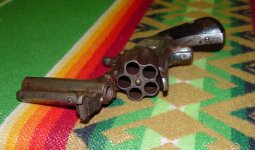Magnum Wheel Man
New member
I have been collecting old black powder cartridge era guns typically smaller "pocket guns" over the last year or so... I typically like center fire cartridges, as I have found several light loads with Trailboss & soft lead round balls that shoot well in these guns...
I reciently picked up an old S&W model 1 1/2 tip up in 32 rimfire to add a top hinge to my collection...
BTW... all my guns are functional, & I shoot most of the center fires, some of the "stonger guns" fairly regularly... I have a 30 rimfire that we made rifled 22 chamber inserts that I shoot Super Colibri's in, & it works well...
I could make similar rifled chamber inserts for the 32 Tip up, but the 32 rimfire was popular enough that there are still "collector" cartridges out there ( finding 30 rimfire is / was pretty tough )... I had to do some restoration repair to my tip up, now, over all it looks & seems fully functional, but I will not keep it if it's not "shootable" being it's an obscure rimfire, means I won't be shooting it regularly, but I need to know that it functions correctly, & have a box of ammo or two on hand for it, before it belongs in my collection...
my local builder is pretty skeptical of shooting it with early 1900's smokeless ammo, ( which we figure would likely have the most stabil & actually useable priming compound ) & I certainly don't want to crack a cylinder ( they are really thin & made of pretty soft iron on this model ) my builder suggested I "lighten" the bullets if I'm going to test fire it with that type of ammo... we are thinking about pulling one bullet, & determining how much to cut off the tip of the bullet, basically making it a flat nose, then perhaps even drilling out the center of the bullet some to further lighten the bullet, making a light weight hollow point out of the old round nose factory ammo... this would greatly reduce the chamber pressure on that early smokeless ammo... for me to use to test fire the revolver...
I'm not so worried about the collectability of the ammo as having a box or two to keep with the gun... I could see altering as much as a whole box, & putting it in a modern plastic ammo box, & selling off the old collectable box... this would of course depend on if the old rimfire ammo would fire in the 1st place ( part of the reason I'm looking for as new a box of 32 short rimfire in the 1st place )
has anyone else ever "lightened up" bullets on factory loads, with lowering chamber pressures as a motivating factor ???
ever tried shooting good condition ( properly stored ) rimfire ammo of this era ??? if so, you have a ballpark on how many actually fired ???
thanks...MAG
I reciently picked up an old S&W model 1 1/2 tip up in 32 rimfire to add a top hinge to my collection...
BTW... all my guns are functional, & I shoot most of the center fires, some of the "stonger guns" fairly regularly... I have a 30 rimfire that we made rifled 22 chamber inserts that I shoot Super Colibri's in, & it works well...
I could make similar rifled chamber inserts for the 32 Tip up, but the 32 rimfire was popular enough that there are still "collector" cartridges out there ( finding 30 rimfire is / was pretty tough )... I had to do some restoration repair to my tip up, now, over all it looks & seems fully functional, but I will not keep it if it's not "shootable" being it's an obscure rimfire, means I won't be shooting it regularly, but I need to know that it functions correctly, & have a box of ammo or two on hand for it, before it belongs in my collection...
my local builder is pretty skeptical of shooting it with early 1900's smokeless ammo, ( which we figure would likely have the most stabil & actually useable priming compound ) & I certainly don't want to crack a cylinder ( they are really thin & made of pretty soft iron on this model ) my builder suggested I "lighten" the bullets if I'm going to test fire it with that type of ammo... we are thinking about pulling one bullet, & determining how much to cut off the tip of the bullet, basically making it a flat nose, then perhaps even drilling out the center of the bullet some to further lighten the bullet, making a light weight hollow point out of the old round nose factory ammo... this would greatly reduce the chamber pressure on that early smokeless ammo... for me to use to test fire the revolver...
I'm not so worried about the collectability of the ammo as having a box or two to keep with the gun... I could see altering as much as a whole box, & putting it in a modern plastic ammo box, & selling off the old collectable box... this would of course depend on if the old rimfire ammo would fire in the 1st place ( part of the reason I'm looking for as new a box of 32 short rimfire in the 1st place )
has anyone else ever "lightened up" bullets on factory loads, with lowering chamber pressures as a motivating factor ???
ever tried shooting good condition ( properly stored ) rimfire ammo of this era ??? if so, you have a ballpark on how many actually fired ???
thanks...MAG
Last edited:


